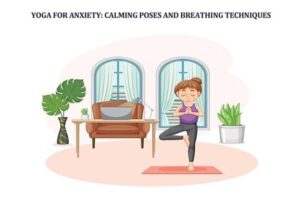Featured Image Caption: Yoga Illustration
Jump to read...
What lies beyond the poses? Have you ever stopped in the middle of a pose and asked yourself what is all this really for? The breathing. The balance. The silence between breaths.
Yoga is a workout for most people. Something that makes your back a little longer, and your nerves a little cooler. Might even burn a calorie or two. But yoga, oh, it’s so much bigger than that. Way deeper. It’s a whole philosophy – a perspective on life, yourself, and the world around you.
Behind every push, behind the slow pull of air into your lungs is an ancient intelligence murmuring. Yoga is not only about how much your body can bend. It is about how open your mind can get.
It is an ancient vehicle of personal change, and today, as India’s heritage has become an industry for millions of visitors a year, from your local studio to the West’s great yoga temples, there is always the same hushed message: you are more than your thoughts. More than your worries. More than the noise. It’s not just exercise. It’s evolution.
The Roots of Yoga: A Journey Through Time
Before yoga became a practice of physical exercise, it was a deeply spiritual pursuit. About 5000 years ago, yoga was practiced in Ancient India, where sages meditated in the mountains, forests, and by the rivers in search of the deeper connections of life.
According to them, it was yoga, a Sanskrit word meaning to yoke, or unite.
What was to be united? The body, mind, and soul. A simple answer, yet a deeply complex one: especially until you try.
The very first mentions of yoga can be found in the ancient Indian teachings, the Rig Veda. It was not about balance and doing spins. It was about merging with the transcendent. The Upanishads and the Bhagavad Gita later elaborated the idea. Action and awareness found a bridge, A new form of yoga.
The great fount of Indian philosophy, Patanjali, structured yoga like no other. The Yoga Sutras by Patanjali are brief yet rich in meaning. Patanjali states, “Yoga is the stilling of the fluctuations of the mind.” There is no more thought to be given. You cease to seek, and the mind is no longer an invader; the stillness of the chase has been done. You arrive.
Over the years, the practice of yoga has branched into many unique and different forms. The forms of yoga, Bhakti (devotion), Karma (action), Jnana (knowledge), and Raja (meditation) are all uniquely different yet harmoniously aligned to achieve the goal of peace.
The heart of yoga remains the same, an inward journey, as it has evolved and expanded to new places, as gyms with sturdy gym mats, homes, and even beaches.
The Essence of Yoga Philosophy
Change is at the center of the practice of yoga. Not the body but the Being.
It says that happiness is not to be found in things. Not in jobs. Nor in cars. Or perfect relationships. Happiness is when the mind is quiet, when it stops rushing to the future and going to the past.
Happiness is a complex matter. It takes every bit of yoga philosophy to arrive at it. Balance is essential. Balance between effort and ease. Balance between control and surrender. The mind is powerful, and it is capable of bringing things into existence.
With every yoga posture, every breath is a dialogue between the body and the mind. You bend. You hold. You shake. And then, the most sobering realization dawns, it is not the mat that is a battlefield. It is you. That is yoga.
The Eight Limbs of Yoga: A Path to Freedom
Patanjali’s Ashtanga Yoga – the eight limbs – is a kind of roadmap to a better life, and it is for everyone, not just monks or yogis. It’s something anyone who cherishes peace can gain from. Let’s simplify it a bit.
Yama – Moral restraints
Yama is the first limb of yoga, which consists of being compassionate, truthful, non-stealing, self‐controlled, and not greedy. It’s easy, but to adhere to those principles is so much harder.
Niyama – Self-discipline
Niyama: Take care of one’s body & mind. Observe Kegan’s practice. Conversation, care. Mental and physical gentleness. Self-control. Serving, etc.
Asana – The Poses
Everyone’s heard of yoga. The goal isn’t to touch your toes, but rather to learn how to come up through the sore places or the tension points.
Pranayama – The Breath
Breathing the right way can change your life. The yogis and the yoga instructors themselves are very confident of the value of breathing in the energization process.
Pratyahara – Withdrawing the Mind from the External World
This is to close off the senses for the world and turn them inward.
Dharana – Concentration
Being able to concentrate on one thing, without allowing any new thoughts to take you away from it, is an ability worth its mettle.
Dhyana – Meditation
Awareness is calm, and the stream of thinking, which is usually busy, begins to rest like water.
Samadhi – Unison
The last step to life. This is complete oneness and ultimate bliss, which culminates in freedom from all separateness.
Every limb is built upon the other. Mindfully, you take thoughtful walks up the inner staircase, one peaceful breath after another.
The Mind: Friend or Enemy?
The mind’s activity has a hop, skip, and a jump. The planning, the inner dialog, worrying, and judging. It is more like a radio that is stuck on one channel.
Yoga says listen, and it is okay not always to listen. Nothing is peaceful with a mind like that. The restless mind has to be calmed, and that is where everything becomes clear. The tool? Meditation. You sit. You tighten your breath. You focus on the thoughts and let them go.
At first, it is all a jumble. Space begins to form, and little by little, you almost get the sense that thoughts are not you. It is in that silence that the defeatist mind has something to say, and it is fascinating how the flow of life begins to happen the moment you stop resisting.
The Body as a Sacred Space
The act of yoga itself is to infuse life in a functional tool that is more than that, a vessel – a temple of the spirit. The more you begin to hear it and understand the awe of movement, the more you listen and learn to regain yourself. The focus is more on relearning gentleness.
Even in contemporary studios, yoga invites you to deepen your consciousness. The space you create – neat yoga mats, softened light, and soothing sounds – shows your internal quietude.
Like sacred art, your body is to be revered. Your body is not an obstacle. It is the way. It is the path. It is to be loved and respected.
Karma and Detachment: Doing Without Clinging
Finish what you have begun, but do not attach yourself to the outcome. Sounds simple. Feels impossible. I suppose it is because not all of us are familiar with the concept of Karma Yoga.
Yoga that is action-oriented. In your case, not being attached to the outcome. The Bhagavad Gita put it beautifully: “Perform your duty, but do not become bound by the outcome of your actions.”
It is not the same as not caring. It’s anxiety-free caring. You do your best, and then simply let life happen. You feel light when you relinquish certain expectations. You realize that you have never had complete control.
Yoga teaches this over and over, on the mat, in life. You come out of a certain pose and you go back in. You lose and learn. That is yoga too.
The Breath of Life: Pranayama
Breathing is necessary; it is almost like a bridge joining the physical and the non-physical. ‘Prana’ is the life force, ‘ayama’ is the expansion. Jointly, the means of life energy expansion.
Like ordering the chaos, focusing on the action of breathing eases the heart, quiets the mind, and calms the nervous system.
Only a few counts, like with ‘Anulom Vilom’ or ‘Bhramari’, can release stress. The next time you feel all bent up, try this. With the body still, take a large breath and slowly let it out, and take your time. Everything will be alright; the world is a compassionate place.
In yoga, ‘samyama’ is the term used for focusing the mind and the breath, and in such, you free the heart.
Meditation: The Still Point
Meditation is the first foundational step in yoga and the most basic. Don’t let the jargon confuse you. You have to take a seat simply. Your mind will first, and your first thoughts to take some action, will be to fight.
There will be some deep thoughts, and you will begin to feel some frustration. You will tend to move a lot. For a, the goal is to try and tough it out.
The storm starts to cheer. Liquid is cornered. The calm, yet deep oasis is now visible, and it is something you never knew existed. Dhyana, as told in the Yoga Sutras, is a constant stream of consciousness. No movement is made. No control presents. Only is.
Being called “you” is a term that most of the time is forgotten about ourselves. In that, you can see you are separate– not your title or your narrative. The serene, passive is. The observer. That is liberty.
The Spiritual Thread in Yoga
This is where yoga gets interesting. It’s not a religion, yet it does something, strangely. Yoga claims that everything is intertwined – the stars, the dirt, the soul. When you exhale, you agree, whole.
There are many ways to connect, such as chants, meditation, or even prayer. It is not the point to worship, but to recognize that the outside divinity is within.
This recognition is humbling. It is also softening. It is also not how you start to behave, but instead how others change the way you act.
You begin to demonstrate care. A realization that everyone is fighting a battle within. Yoga is not just a question or a theory, but a practice to instill sympathy, warmth, and kindness.
Yoga in Daily Life: Off the Mat
Yoga is enduring the lesson even during the absences and separating the practice on the mat. Speech or actions performed in kindness and compassion. Accepting an ingratitude. Adjusting inner terms of a confrontation. Living yoga, choosing to forgive.
Tiny acts of yoga also exist in small acts of yoga ‘everyday’ – for example, forgiving strangers, active listening, reacting, or even something as simple as breathing. Within the workplace, one may practice Karma Yoga. One applies devotion and energy to the process and disregards the result.
Within interpersonal dynamics, one practices ‘Ahmisa’ or ‘non-violence’ despite gentle articulation. Yoga is even more beautiful in its absence of yoga paraphernalia. Only awareness. Only presence.
Conclusion
So here we are. Back where we started. Asking what is yoga, really? It’s not just movement. Not just meditation. It’s awareness. Its presence. It’s remembering who you are when the noise fades.
A journey. With grace, and at times with pure messiness. Falling, and rising. Your heart beats, and you practice. The less you do, the more yoga becomes part of you. The more you keep the performed aspects of you quiet, the more yoga seeps through the silences in you.
In the end, it’s not escaping the world. Its yoga keeping the world gentle, conscious, and full of love. Start now. Roll your mat, and sit still. Breathe. The ‘real’ yoga begins now.




















Leave a Reply